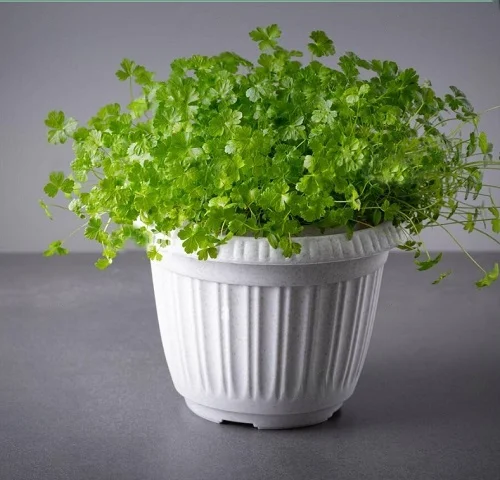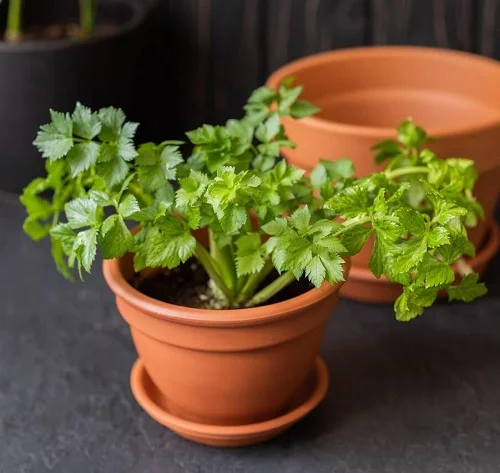Growing Celery in Containers | Pot Grown Celery
Learn Growing Celery in Containers in easy steps with the help of this comprehensive guide, and enjoy it fresh in your food!

Here’s everything about Growing Celery in Containers that will help you cultivate it easily for your kitchen!
Celery Plant Information
Celery (Apium graveolens) is an herbaceous plant from the parsley family (Apiaceae), which is commonly used as a delicate flavoring in various dishes such as stocks, soups, and casseroles and cooked as a vegetable.
The long fibrous stalk of celery tapers into leaves and is consumed and used in cooking, along with its hypocotyl or leaves, depending on the location and cultivar.
In the United States, it is served raw as an appetizer, with dips or spreads, and also used in salads. Celery seed, which has a taste and aroma similar to the plant, is used as a seasoning, especially in pickles and soups. These tiny seed-like fruits are commonly known as celery seeds.
Best Celery Varieties for Containers

Before you plan on Growing Celery in Containers, have a look at the best varieties.
- Tall Utah: This stringless variety with 12-inch stalks has a light flavor and a 100-day growing season.
- Golden: It has a quick growing season, 85 days from germination to harvest. This celery has thick, stringless stalks and light color.
- Pascal: With a 120-day season, Pascal is a frequently cultivated celery variety in North America. It grows up to 12 inches in height and is suitable for container gardening, tolerating some shade.
Best Container Size for Celery
For Growing Celery in Containers, it is important that you pick the right pot. Select a container that is at least 8 inches deep. As celery roots only grow a few inches deep, a moderately sized pot with a diameter of 8-10 inches is adequate. If you possess an extra small container, it could be a good option for growing celery.
It’s best to avoid terracotta or clay pots, as they dry out quickly and absorb moisture, which isn’t ideal for celery growth. Since celery requires moist or wet soil, plastic or glazed containers are a better choice. If you plan to grow multiple celery plants, it’s advisable to use a long, shallow planter.
When to Grow Celery
For Growing Celery in Containers, fall or spring are the best seasons, owing to favorable climatic conditions. If you do not reside in a cool climate throughout the year, it is advisable to plant celery during mid-winter or mid-to-late summer.
If you reside in a location with a brief cool season, container gardening is beneficial for growing celery. Starting the celery in pots indoors during the early season and then shifting it outside for the rest of the cool period can be helpful.

Celery thrives in cool temperatures and has a slow growth rate, taking around 90-130 days from germination to harvest. For Growing Celery in Containers, the optimal temperature is between 40-70 degrees F over a period of 15-16 weeks.
Deviations from this temperature range, either higher or lower, can lead to the plant producing flowers and seeds, stunting its growth.
Starting Celery from Seed
Growing Celery in Containers is really easy from seeds.
- Celery is intolerant to heat and necessitates a prolonged cool season for growth; it’s recommended to start seeds indoors 10-12 weeks before the final anticipated frost for a spring harvest. For a fall growing season, seeds should be sown 10-12 weeks before the first expected fall frost date. In warmer climates, celery must be planted during the mid-winter.
- Before planting, soak the seeds overnight in warm water, sow them 1/4 inches deep, and pat down the soil gently.
- For Growing Celery in Containers, use an 8-inch pot, and sow five seeds with 2 inches of space between the seeds.
- Keep the soil warm and moist; place the pot on a sunny window or on a heat mat.
- The seeds will germinate in 1-3 weeks after sowing.
- Once the celery seedlings grow up to 3 inches in height, use kitchen scissors to thin them, leaving only the healthiest ones. Place the remaining seedling in a sunny window and remember to keep the soil moist.
- Feed the seedlings with seed-starting fertilizer when they are a few weeks old.
- Due to its taproot, celery dislikes transplanting. If you started the celery in seed-starting containers, ensure that you transplant them to their larger container once they have grown at least three sets of true leaves. After transplantation, it is best to leave the celery alone, as disturbing the delicate roots may have adverse effects.
Growing Celery in Water

Growing Celery in Water is easy and is one of the best options for Growing Celery in Containers. You can relish a fresh harvest at home without the need to buy it from a grocery store ever again!
Requirements for Growing Celery in Containers

Sunlight
For Growing Celery in Containers, choose a spot with at least six hours of sun per day. If feasible, locate a spot on your deck, balcony, or patio that receives direct sunlight for a minimum of 6-8 hours daily.
Note: During peak summer, it’s advisable to relocate the containers to a shaded spot in the afternoon.
Soil
Use rich soil amended with plenty of aged compost or organic matter and a handful of coffee grounds for Growing Celery in Containers. Celery prefers a soil pH of 6.0 to 6.5, alkaline. To cut the acidity in the acidic soil, add limestone to it.
Water
Celery requires an abundant water supply to develop its characteristic flavor and crunchy texture. Insufficient watering may cause stunted growth, hollow stems, and bitterness.
While Growing Celery in Containers, ensure it receives a weekly minimum of 1-1.5 inches of water while maintaining the soil moisture levels almost constantly. Adding mulch can also aid in retaining moisture.
It can be tricky to maintain consistent water levels as the soil dries out faster. Therefore, it’s essential to apply mulch and provide an ample water supply to quench the thirst for your celery.
Temperature
The best temperature range while Growing Celery in Containers is between 60-70°F (15-21°C). Celery does not tolerate extreme cold or heat, so temperatures below 50°F (10°C) or above 75°F (24°C) can cause stunted growth or even death.
Celery Care in Pots

Fertilizer
Adding compost or manure during the initial planting is recommended, and supplementing with organic fertilizers like fish emulsion every 2-3 weeks or aged compost every month is advised.
Diluting the fertilizer with water and using it as a foliar spray can also aid in nutrient absorption through both roots and foliage.
Blanching
While Growing Celery in Containers, it needs to be blanched 2-3 weeks before harvesting, or else it will have an unpleasant bitter taste. Blanching involves scalding produce in boiling water, but this method does not work for celery as it can make it mushy and bitter.
To properly blanch celery, wrap the stalks a few weeks before harvest to prevent exposure to light, which triggers the production of chlorophyll and bitterness. This can be done by wrapping the base of the plant with newspaper or paper grocery bags and tying it with a string or twine. Other methods, such as mounding or using milk cartons, also work well.
Harvesting Celery

When you grow Growing Celery in Containers, it gets ready to harvest between 100-120 days after germination, and it should be at least 6 inches tall from the base to the first leaves. You can either harvest individual stalks as you go or wait until the whole plant is ready and harvest all at once.
When harvesting individual stalks, cut them off near the base with a sharp knife, starting with the outside stalks. To harvest the whole plant at once, cut along the base at the soil level. If you are growing celery in pots, harvesting individual stalks as needed will probably serve you better.
Best Ways to Use Celery

1. Homemade Chicken Stock
- Growing Celery in Containersalong with herbs like thyme, oregano, rosemary, and celery is a great way to ensure you always have fresh ingredients for homemade stock.
- When you’re ready to make your own stock, simply clip a few sprigs from each herb plant using sharp scissors.
- To make the stock, combine the herbs with a leftover chicken carcass (a rotisserie chicken is perfect for this) and some veggie scraps.
- Break up some homegrown celery stalks, including the leaves, into large pieces and add them to the pot.
- Fill the pot with cold water to about 2-3 inches above the ingredients and bring to a boil. Reduce the heat and simmer for 6+ hours. Season with salt and pepper to taste.
- Once the stock is done, strain it and use it fresh or freeze it for later. Homemade stock is perfect for soups, sauces, cooking rice, or even sipping from a mug.
- It’s a healthy and delicious option that will impress you and keep you from buying stock in a carton ever again.
2. Celery Juice
Growing Celery in Containers will give you access to its fresh leaves that can be added to green juice. It is an excellent source of vitamin K, potassium, calcium, magnesium, vitamin C, and other beneficial nutrients.
Interestingly, some people drink fresh celery juice daily in the morning as a health practice. Starting your day with a large serving of green goodness through celery juice gave you a newfound appreciation for this crunchy, hydrating, low-calorie vegetable.
Celery Health Benefits
Growing Celery in Containers also means that you can reap these benefits.
1. Supports Healthy Digestion: Celery contains a good amount of dietary fiber, which helps to increase the bulk of your stool and stimulate peristaltic motion, which helps to move food through the digestive tract more quickly and efficiently.
2. Aids Weight Loss: Celery has a low-calorie count and is composed mostly of water, making it a great food to incorporate into your diet if you are trying to lose weight.
3. Provides Antioxidants: Celery contains vitamin C, beta-carotene, and flavonoids, which help to protect the body’s cells from damage caused by free radicals.
4. May Help Lower Blood Pressure: Celery contains a compound called phthalide, which has been found to help relax the muscles surrounding the arteries, allowing the vessels to dilate and reduce blood pressure.
5. Contains Anti-Inflammatory Properties: Celery contains polyacetylene compounds that have been shown to have anti-inflammatory effects. This can help to reduce inflammation in the body and reduce the risk of certain diseases.
6. May Help Lower Cholesterol Levels: The soluble fiber in celery has been found to help reduce levels of cholesterol in the blood, which can reduce the risk of heart disease.
